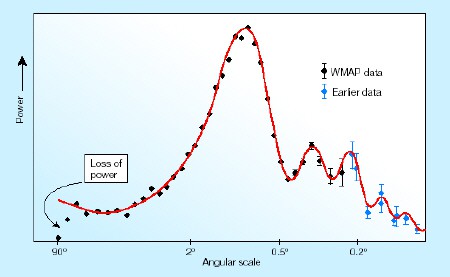The standard model of cosmology predicts that the universe is infinite and flat. However, cosmologists in France and the US are now suggesting that space could be finite and shaped like a dodecahedron instead. They claim that a universe with the same shape as the twelve-sided polygon can explain measurements of the cosmic microwave background – the radiation left over from the big bang – that spaces with more mundane shapes cannot (J-P Luminet et al. 2003 Nature 425 593).

The cosmic microwave background provides a picture of the universe as it was some 400 000 years after the big bang. By this time the universe had cooled down enough for atoms to form, which meant that there were no longer any free electrons to scatter the photons produced in the early universe. Any variations or anisotropy in the temperature of the background radiation therefore reflect variations in the density of the universe at this time.
These temperature fluctuations can be expressed as a sum of spherical harmonics, and astrophysicists plot the relative strength of these harmonics as a function of angle. The height and positions of the peaks in this so-called ‘power spectrum’ are related to basic astrophysical properties of the universe.
Data from the first year of the WMAP satellite – unveiled in February – agreed with the predictions of the standard big bang plus inflation model of cosmology for regions of space separated by small angles. However, on larger angular scales – greater than 60° – the WMAP observations were significantly lower than this model predicted (figure 1).
Jean-Pierre Luminet of the Observatoire de Paris and colleagues believe that the finite size of the universe itself is responsible for this behaviour. Moreover, they show that the predictions of a model in which space consists of 12 curved pentagons joined together in a sphere agrees with the WMAP observations (figure 2). Their ‘small’, closed universe should be about 30 billion light years across.
“Our work really addresses this ancient question of whether the universe is finite or infinite,” team member Jeff Weeks, a freelance mathematician based in New York, told PhysicsWeb. “The exciting point is that this is no longer pure speculation – we now have real data.”
The team says that its result, if confirmed, will have implications for theories and models of quantum gravity, inflation and the big bang itself. However, the model needs to be tested further by studying the microwave background at larger angles using more data from WMAP and the Planck Surveyor, which is due to be launched later this decade.




